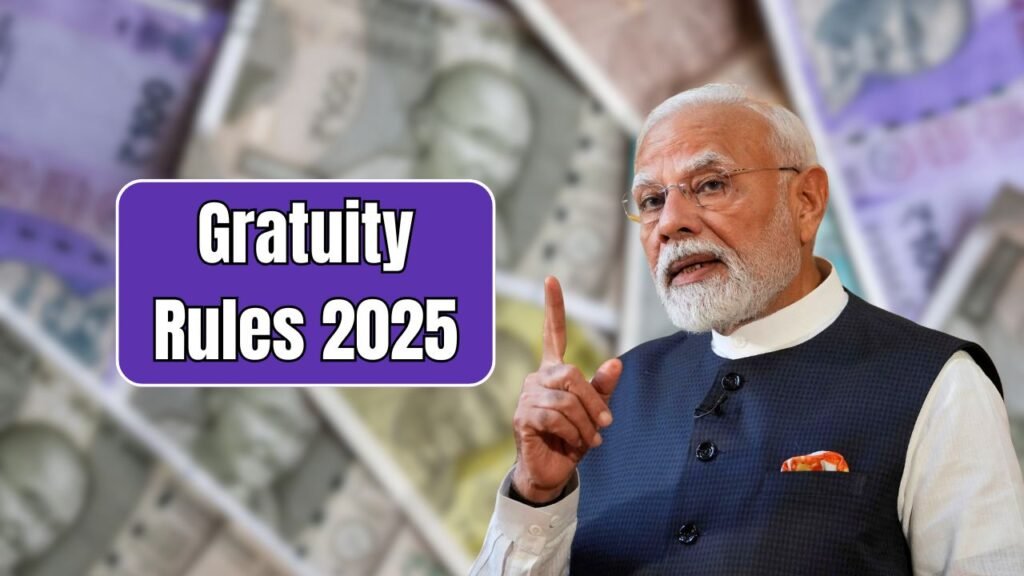For many employees in India, gratuity is an important part of retirement and savings. It is a one-time payment given by the employer to the employee for long and loyal service. In 2025, the government introduced new gratuity rules to make the system more fair and clear. These rules apply to government employees, private employees, and even contractual workers. Now, you can easily know how much gratuity you get after 5, 7, or 10 years of service.
What is Gratuity and Who Gets It?
Gratuity is a legal benefit under the Payment of Gratuity Act, 1972. An employee becomes eligible for gratuity after completing at least five years of continuous service. It is paid when the employee retires, resigns, or leaves the job due to superannuation.
Earlier, many employees were unsure about the exact gratuity amount or the time of payment. With the new 2025 rules, the system has become more smooth and quick.
What’s New in the Gratuity Rules of 2025?
The new rules are more inclusive and transparent. They clearly cover employees in small companies and those working on contracts.
Employers must now follow strict timelines for paying gratuity. The calculation formula is also fixed, and claims must be settled quickly.
These changes help employees across all sectors plan their finances better and reduce confusion.
Gratuity After 5 Years of Service
The minimum eligibility for gratuity is five years of continuous work. Once you complete five years, you are entitled to gratuity from your employer.
The amount is based on your last drawn salary, which includes basic pay and dearness allowance, along with the number of years you worked.
With the new rules, even small company employees and contract workers get gratuity after five years.
Gratuity After 7 Years of Service
After seven years of service, the gratuity amount increases. The longer you stay, the more you get.
The rules highlight that gratuity grows with service years. This gives employees better financial support when they retire or change jobs.
Employees can now clearly understand how their gratuity increases with time.
Gratuity After 10 Years of Service
Ten years of service is a major milestone. At this stage, gratuity becomes a strong financial backup.
The new rules ensure faster and fair payouts for long-serving employees. Those who complete 10 years or more can expect a higher and timely settlement.
This benefit helps employees plan retirement with more confidence.
How Is Gratuity Calculated?
The new rules make the calculation simple and standard. Many big organizations also use automated systems for this.
The formula is:
Gratuity = (Last Drawn Salary × 15 × Years of Service) ÷ 26
Here:
- Last Drawn Salary = Basic + Dearness Allowance
- 15 = 15 days of salary for every year worked
- 26 = Number of working days in a month
Example Table of Gratuity Calculation
| Years of Service | Last Drawn Salary (₹) | Gratuity Formula | Gratuity Amount (₹) |
| 5 Years | 25,000 | (25,000×15×5)÷26 | 72,115 |
| 7 Years | 25,000 | (25,000×15×7)÷26 | 1,01,961 |
| 10 Years | 25,000 | (25,000×15×10)÷26 | 1,44,230 |
This table shows how gratuity increases with more years of service.
Why These Changes Matter for Employees
The new gratuity rules bring many benefits for employees:
- Clear and simple formula for calculation
- Faster payments without long delays
- Coverage for contractual and small firm employees
- Better planning for future and retirement
Employers also benefit as the rules reduce disputes and make the process easy to manage.
Conclusion
The 2025 gratuity rules make the system fair, clear, and reliable. With defined benefits after 5, 7, and 10 years, employees now know exactly what they will get. Faster payouts and inclusion of all employees make the rules more useful.
No matter if you work in government, private sector, or on a contract, your years of service will now be rewarded in a timely and fair way.
Disclaimer: This article is for informational purposes only and should not be construed as legal or financial advice. For personalised advice on gratuity rules, please contact official government sources or a qualified professional.




